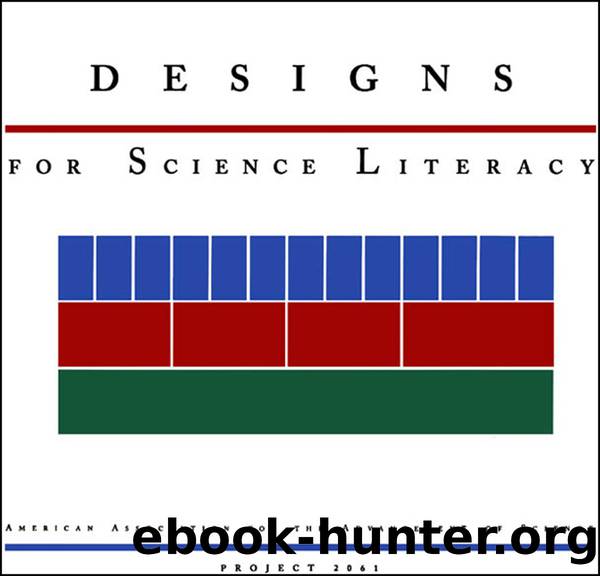Designs for Science Literacy by American Association for the Advancement of Science American Association;

Author:American Association for the Advancement of Science, American Association;
Language: eng
Format: epub
Publisher: Oxford University Press, Incorporated
Published: 2000-08-15T00:00:00+00:00
PALLADIO UNIFIED SCHOOL DISTRICT
Palladio Unified School District is located in a very large, heavily populated urban area. Its student population has changed dramatically over the decades, largely reflecting the waves of migration that have passed through the city, and its financial health has mirrored the ups and downs of the regionâs industrial base. Currently, African-American, Hispanic (mostly Central American and Caribbean), and Asian-American (mostly Southeast Asian) students make up most of the Palladio student body, although the overall proportion of those minorities in the city itself is considerably less. More than a third of the students come from working-poor and under-employed families. In spite of federal aid and state equalization funds, the school district is unable to secure the financial resources it feels it needs to put it on a par with the school systems in the surrounding suburbsâor, more critically, to reach the ambitious goals it has set for itself.
Nevertheless, this is not a school district in disarray. In its century and a half, it has faced severe challenges time and again, enjoyed its share of successes, survived its failures, and believes that such is its fate. Palladio Unified exists in a very political city that never hesitates to criticize its institutions, a city that is often at odds with the state and the courts over school matters. Yet surveys show that a substantial majority of parents and citizens believe the schools are making headway in the face of the cityâs current challenges. One reason may be that because they live in a city of neighborhoods (some of which were formerly villages bordering the city proper that were incorporated into the city against opposition that has never entirely subsided), parents and citizens focus more on their particular schools than on âthe system,â and they do not think that criticism (or even praise) of the school system as a whole has much to do with them.
Because of that attitude, and because the districtâs rather rapid turnover of superintendents and school-board members has made it difficult to create and sustain a strong central bureaucracy in any case, Palladio has never become strongly centralized. Thus, the districtâs name not withstanding, creating a single districtwide curriculum has never been in the cards for Palladio Unified. With regard to this curriculum-design undertaking, everyone understood that the role of the central administration and board was to set directions, provide incentives for action, distribute resources fairly, monitor progress, and take care of legal and financial oversight.
Settling on a Process
In a series of joint meetings in various sections of the city, the Palladio school board suggested to teachers, principals, and parents that after nearly a decade of making worthwhile but piecemeal improvements in the curriculum, a more thorough and coherent curriculum was in order. As increasingly close attention had been paid to specific learning goals, it had become more and more evident that students were not learning well. Moreover, the faculty now had the ability to design a curriculum. This board declaration was neither surprising nor unwelcome.
Download
This site does not store any files on its server. We only index and link to content provided by other sites. Please contact the content providers to delete copyright contents if any and email us, we'll remove relevant links or contents immediately.
Macmillan Primary Grammar 2 Pupil's Book by Unknown(374)
Figuring Out Fluency in Mathematics Teaching and Learning, Grades K-8 by Jennifer M. Bay-Williams & John J. SanGiovanni(341)
The Principal's Guide to Curriculum Leadership by Sorenson Richard D.;Goldsmith Lloyd M.;Mendez Zulma Y.;Maxwell Karen T.;(263)
English Grammar Practice--The Noun by Roxana Nastase(227)
Learning from Accidents 3rd ed by Trevor Kletz (2001)(225)
Harnessing Technology for Deeper Learning by Scott McLeod(212)
Text-Dependent Questions, Grades K-5 by Douglas Fisher & Nancy Frey & Heather Anderson & Marisol Thayre(206)
English Language Program Administration by Unknown(199)
A Guide to Curriculum Mapping by Hale Janet A.;(197)
Deep Change Leadership by Reeves Douglas;(187)
How to Do Everything with Google Tools by Unknown(185)
The Grammar Teacher's Activity-a-Day by Jack Umstatter(177)
The Power of SMART Goals by Conzemius Anne;O'Neill Jan; & Anne Conzemius(175)
Beyond the RTI Pyramid by Bender William N.;(157)
Aligning and Balancing the Standards-Based Curriculum by Squires David A.;(153)
Using Data to Close the Achievement Gap by Johnson Ruth S.;(153)
Using Equity Audits to Create Equitable and Excellent Schools by Skrla Linda E.;McKenzie Kathryn B.;Scheurich James Joseph;(149)
Differentiated Instructional Strategies for the Block Schedule by Gregory Gayle H.;Herndon Lynne E.; & Lynne E. Herndon(138)
You've Got to Reach Them to Teach Them by Schreck Mary Kim; & Schreck(137)
